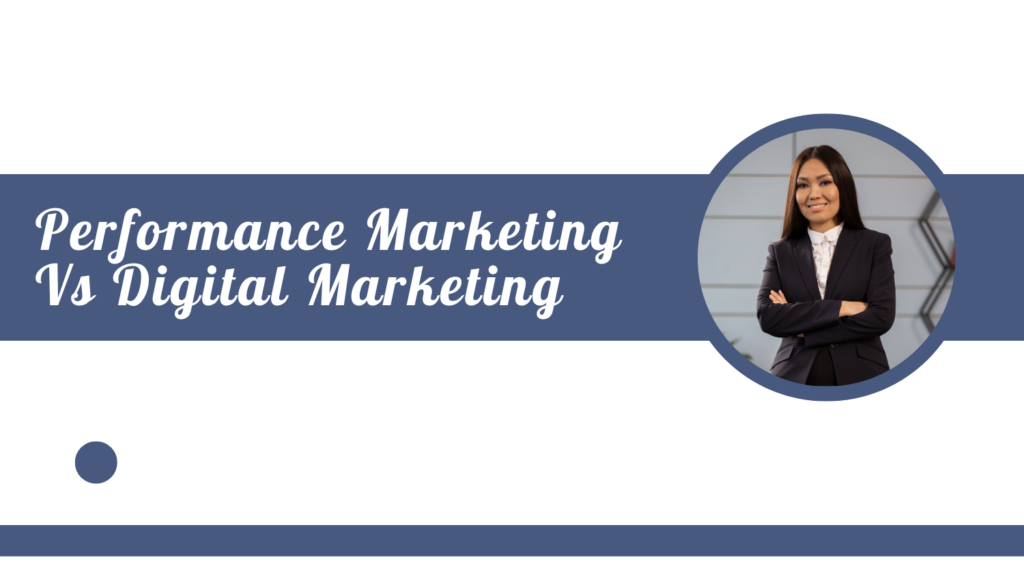Performance marketing vs digital marketing differ primarily in their marketing approaches. Digital marketing that focuses on results is called performance marketing. Using various channels, digital marketing promotes brands, sells products, and connects potential customers. A variety of payment models, strategies, and channels are available in digital marketing.
Performance marketing involves optimizing these channels and strategies. Digital marketing has longer-term goals than performance marketing. Metrics of performance marketing are easy to measure. Performance marketing produces the fastest and most visible results. Performance marketing produces results faster than digital marketing.
How do Digital Marketing and Performance Marketing differ?
Using the internet, digital marketing connects potential customers. The purpose of digital marketing is to increase a business’s digital presence. Digital tools are used to drive traffic to a website. Digital tools include social media, email marketing, search engine marketing, display advertising, video marketing, mobile marketing, and pay-per-click advertising. Among the goals of digital marketing are lead generation, conversion, brand awareness, and reach.
The term performance marketing refers to a specific type of digital media advertising. Performance marketing is based on clients’ actions, such as clicks, sales, and leads. To analyze the results of performance marketing campaigns, marketers need to set the proper budget and impressions. Performance marketing is a performance-based marketing strategy. Paid media such as Google Adwords, Facebook ads, LinkedIn ads, and banner ads are used for performance marketing. Lead generation and conversion are the only goals of performance marketing. Banner ads, native advertising, content marketing, social media, and search engine marketing (SEM) are performance marketing channels.
Performance marketing allows advertisers to only pay for an ad’s performance instead of paying for an advertisement in digital marketing. The performance of a campaign is determined by the number of leads, impressions, likes, and shares. Brand awareness and interaction with target audiences are created through digital marketing. In digital marketing, advertisers do not pay for actual conversions. In performance marketing, advertisers pay for leads and for converting them into customers. Understanding digital marketing vs. performance marketing is crucial.
Performance marketing metrics
Cost Per Mille (CPM): It is the cost of showing a digital ad every 1000 times to viewers. This metric is less important to marketers.
A CPC is the cost each time a viewer clicks on the ad.
CPA (Cost Per Action) : measures how well a campaign performs by measuring how many people download, subscribe, sign up, etc.
The lifetime value of a customer is called the Life Time Value (LTV). Each customer’s expected spending.
Digital marketing metrics
Bounce Rate: How many visitors leave a site without taking any action.
Page Views : are the total number of pages viewed.
The conversion rate refers to the total number of conversions from a website.
A click-through rate (CTR): is the ratio of the number of clicks to the number of viewers.

Performance marketing types
Performance-based search marketing
An ad is paid for when it appears on a search engine result page. Traffic is driven to a website by it. With the right keyword, it finds the target audience.
Performance marketing on social media
Paid ads and organic posts on social media, as well as high-quality content, are included. Customers should be able to interact with the content.
Performance-based email marketing
The company uses email marketing to grow its business. By targeting the right audience, it measures the opening rate of emails.
Performance marketing for publishers
Publisher ads appear on websites and apps that the advertiser does not own. A website’s traffic is also increased by it.
Performance marketing via affiliates
For a commission, it encourages customers to buy products and services from the advertiser. By partnering with affiliate publishers and influencers, this can be accomplished.
Different types of digital marketing
Marketing with content
Content creation is the process of creating high-quality and useful content. Content types include blogs, social media posts, videos, webinars, infographics, templates, datasheets, and reports. Provide the audience with useful content.
Marketing through search engines
Search engine optimization involves getting your website to the top of search engine results. To get a better result, you need to know what keywords your audience searches for. This marketing includes paid ads and organic results.
Marketing on social media
Interaction and engagement with customers are possible through social media. To reach the audience, you can make paid ads and post content on social media. Choose the right channel for your product or service. Facebook, Instagram, Twitter, LinkedIn, Pinterest, YouTube, and Snapchat are some of the channels available.
Payment-based advertising
There are two types of payment models for paid advertising. A keyword bidding auction can be used to buy clicks on your ad through PPC (Pay Per Click). When you use a short tail keyword, it will benefit you more in terms of CPM (Cost Per Mile). Every 1000 impressions costs this amount.




Leave A Comment